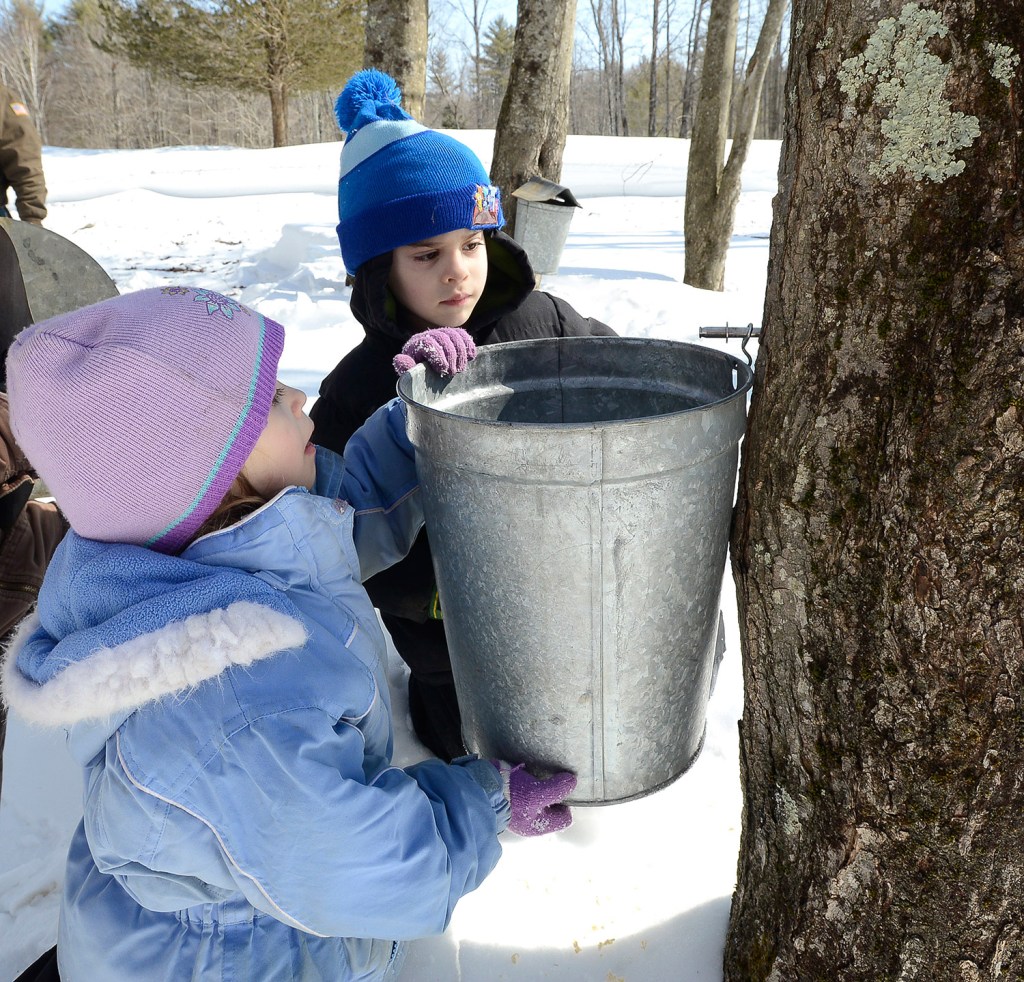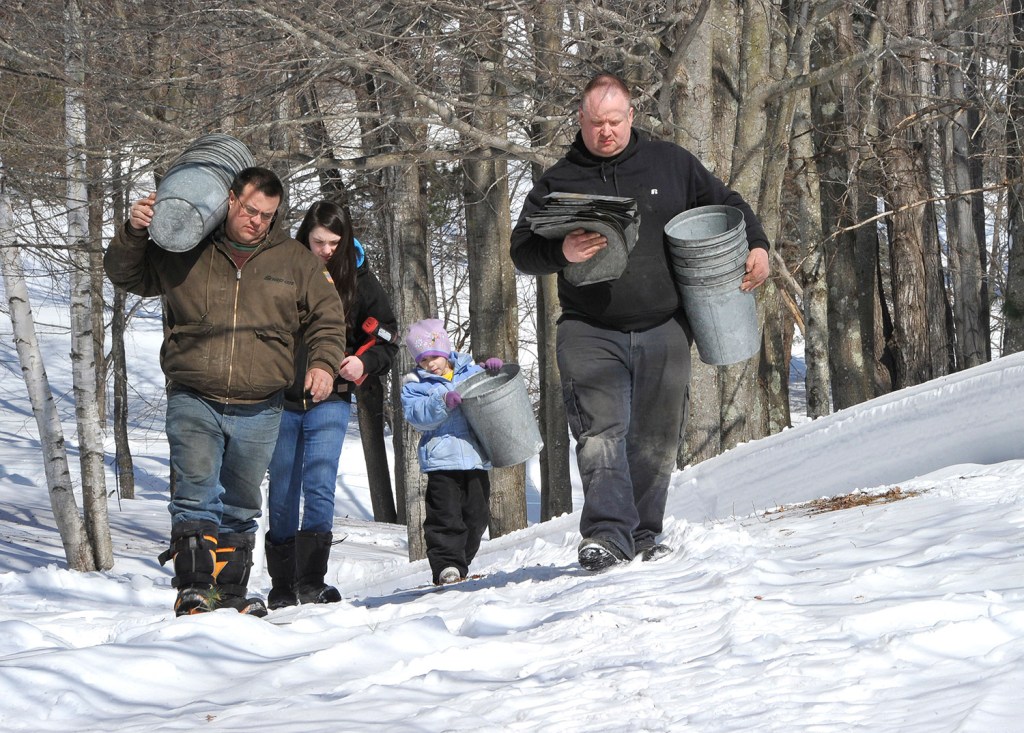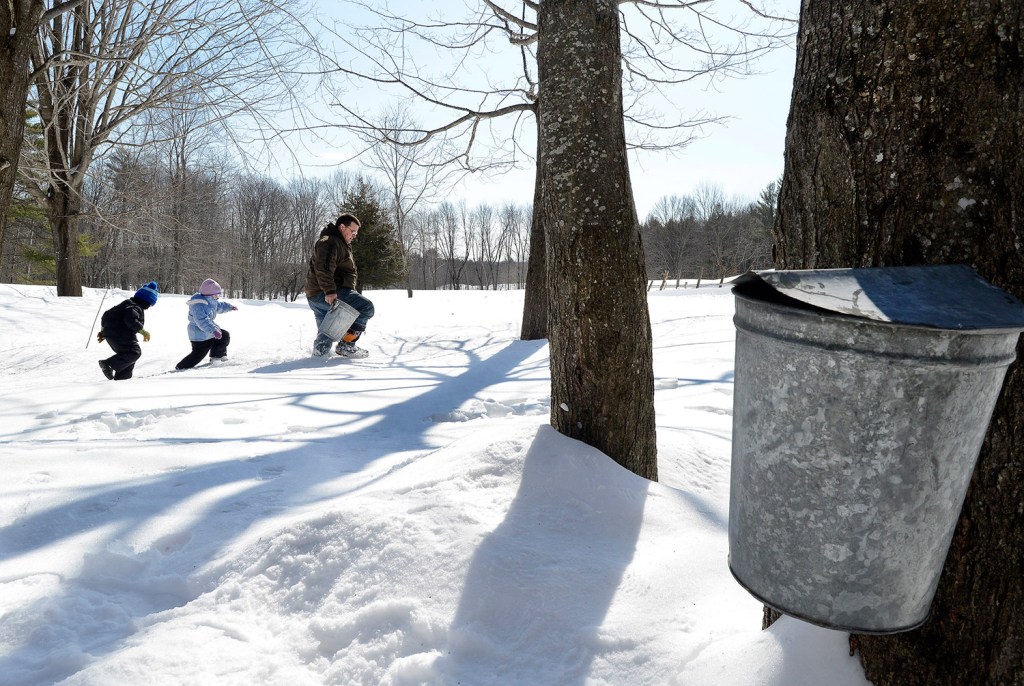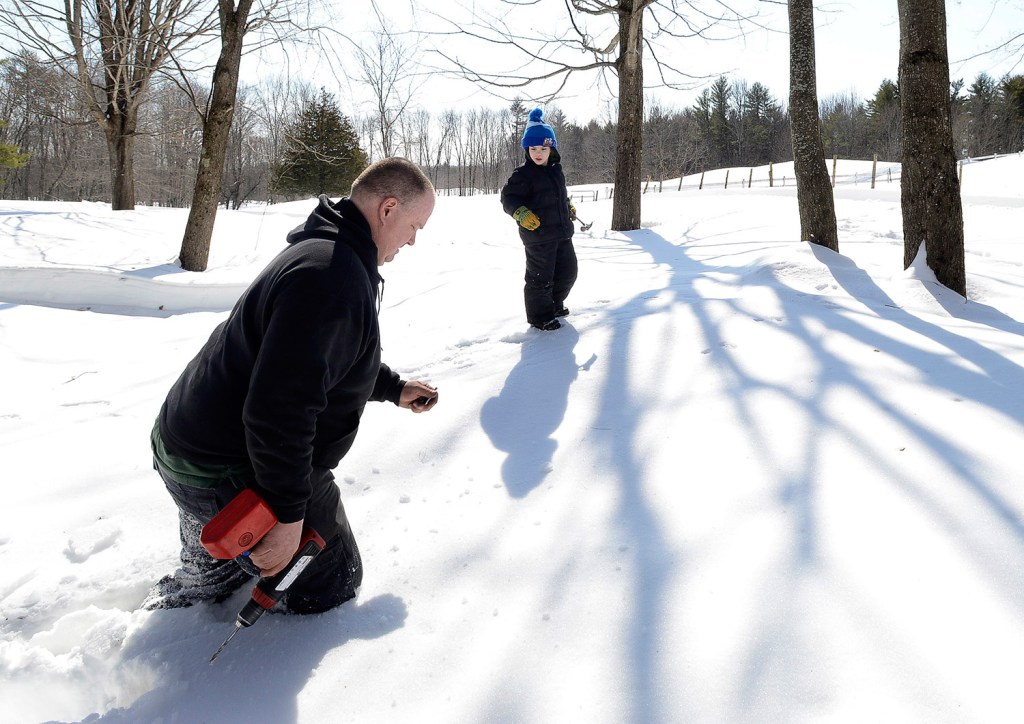What if you’ve been planning a party organized around the bounty of your delicious, fresh-made maple syrup, and thanks to the Siberian-like winter you’ve endured, it is questionable as to whether the sap will flow?
You might have to fake it if the party is the statewide, daylong Maine Maple Sunday coming up next weekend. With thousands of guests expected, Maine producers say creativity is sometimes necessary to make the party look like a proper party.
As in: Put water in the evaporator to generate steam to make it look as if there’s a boil going on. Go buy syrup elsewhere and rebottle it. And count on the baby animals being so captivating that no one cares.
With an estimated $48.7 million maple industry, Maine is the third biggest maple sugar producer in the nation. But that doesn’t mean sleights of hand like swapping in someone else’s maple syrup for one’s own aren’t employed, stealthily and steadily. No one points fingers, and only a few admit to it, but it happens.
“It’s fairly common,” said Mark Cooper of Cooper’s Maple Products in Windham.
‘YOU CAN’T DEPEND ON THE WEATHER’
Traditionally Maine Maple Sunday has been held on the fourth Sunday in March. Sap doesn’t flow unless temperatures cooperate. At night it has to still be freezing, but it can’t be too cold, ideally not below 20 degrees Fahrenheit. During the day, a thaw of 40 to 45 degrees is optimum, according to Maine’s Department of Agriculture, Conservation and Forestry.
It seems reasonable to hope for 40-degree days by early March, but nothing about this winter has been reasonable. By mid-February it was clear that the sugaring season would be at least as late – and likely as short – as it was last year, when sap flowed in Maine from March 21 to April 19, according to the U.S. Department of Agriculture’s National Agricultural Statistics Service.
Last year at Baker’s Maple Syrup in Shirley, just south of Greenville in Piscataquis County, Debbi and Charlie Baker didn’t get a boil until April 7. The sap just wasn’t running on Maine Maple Sunday in late March. They were sapless in Shirley; what were they going to do? “We just kind of faked everything,” Debbi Baker said.
Unlike some, the Bakers are not wont to put water in the evaporator – “it takes too much water,” she said – and they don’t buy syrup from a store or a bulk producer. But they’ve had to resort to calling in favors, asking their friends and neighbors whom they gifted with last year’s syrup whether they still have some left to loan out – just to tide them over through Maple Sunday. For them it’s not about profit; they give away samples all day. But they want the chance to educate the public and to do it in sweet style.
“You can’t depend on the weather,” said Bob Moore of Bob’s Sugarhouse in Dover-Foxcroft. He said he might get “a couple thousand” visitors on Maine Maple Sunday. “You always tuck a few bottles in the corner.” He’s got 6,000 taps, so that’s easier for him to do than some.
He doesn’t fault those who run water through the evaporator since “one picture is worth 10,000 words,” but he doesn’t do it himself. In general, he says, such things aren’t discussed among producers. “Some things they talk about and some things they don’t. I don’t ask.”
Purchasing syrup on the sly is not always about having enough syrup for Maple Sunday. Sometimes it’s about having enough on hand later in the season for the summer tourists, who want to leave Maine with syrup in hand.
“People don’t want to hear this,” said Harry Hartford of the Thurston and Peters Sugarhouse in West Newfield. “But almost all the sugar makers around us, they are out of syrup by May. So they have to go buy syrup at big bulk places, like Bascoms in New Hampshire.”
According to the USDA’s National Agricultural Statistics Service, every maple sugar-producing state except Pennsylvania showed decreased production in 2014. In Maine, with 1.85 million taps statewide and 426 licensed sugar makers, production was down about 3 percent because of the challenges of another long, cold winter in 2013-14. Stockpiles are depleted almost everywhere.
“Normally we try to have about 10 percent of our crop left over to the next year,” Hartford said. He’s got 2,200 taps in and has already had some flow. For every 40 gallons of sap pulled from the tree, producers get a yield of about a gallon. Last year he and his wife, Deborah, made most of their syrup between March 31 and April 10. But last year was a light production year, 476 gallons (in 2013, the Maple Moose’s best year ever, they produced 635 gallons). “This year we are down to about 15 gallons total.”
NO SYRUP SUNDAY
Boiling water instead of sap and supplementing supplies are not federal crimes by any stretch of the imagination. But they represent the dilemma of scheduling a popular, highly lucrative event in the age of climate change and confusing, extreme weather.
One alternative is just bowing out of Maine Maple Sunday, as four Aroostook County sugar houses have done this year, according to the event’s organizer, Michael Bryant. It’s just too early for them. “People come and they don’t have any syrup for them,” Bryant said.
Or they can go with the no-flow, as it were. At Spring Break Maple and Honey in Smyrna Mills the show will go on, regardless of sap. “It’s not unusual for it not to be running on Maine Maple Sunday in Aroostook County,” said Spring Break’s Kristi Brannen, a sugar maker legendary for her maple candy. “We just try to make the best of it.” Making the best of it includes making waiting lists for customers who want some of the 2015 crop. Or if they get a run shortly before Maple Sunday, holding it to boil for the public to see.
About 90 sugar houses will participate in Maine Maple Sunday this year, the bulk of them in the southern and western third of the state – the palm of Maine’s mitten. As the south and coast warmed up last week for a bit, the sap did flow in some locations, at least briefly. And sugar makers are nothing if not optimistic. To a man (and woman), they said they had hopes that “Mother Nature” or “the Good Lord” would set the sap free in time for Maple Sunday.
THREE DECADES OF HISTORY
Maine Maple Sunday started in 1984 as a means of marketing to and educating consumers on the local industry, and it has grown into a wildly popular event, drawing as many as 100,000 visitors from in and out of state. For some of the smaller producers, it’s the year’s best advertisement. “We get a really good crowd that day,” said Cooper of Cooper’s Maple Products. “It brings a lot of customers back throughout the year.”
In a Maine Maple Sunday crisis, someone else’s syrup might get substituted for one’s own, Cooper said. “We do it at times,” he admitted. This entails buying bulk syrup in a 40- to 55-gallon drum and heating it, refiltering it and then packing it oneself. It happens, “but it’s not everybody” doing it, he said. “There are certainly producers that produce more than enough syrup.”
Cooper relies on other Maine syrup, though, like buying from one of the state’s bulk producers in Somerset County. Somerset County had the distinction in the USDA’s 2012 Census of Agriculture of being the largest maple sugar-producing county in the nation, with 1.73 million taps (take that, Vermont, the No. 1 overall producer and Maine’s closest rival). This year he’s lucky enough to still have some on hand from 2014 and he expects to have at least some fresh syrup boiled by then.
At Cooper’s, the syrup likely takes a back seat on Maine Maple Sunday to the four-legged draw – his 30 or so miniature horses waiting to be fawned over. “They are very personable,” he said. “They love attention.” And there will be at least one foal by Maple Sunday. Not that he’s done any engineering in that department. “We don’t plan for that,” Cooper said.
Michael Bryant of Hilltop Boilers in Newfield happily admits he does. “Our goal is to try to have some baby calves,” Bryant said. “You put them together at the right time. The average person doesn’t even think about that.” He’s timed various heifers to deliver by March 22.
Bryant has been sugaring since he was 14 and, after holding various offices with the Maine Maple Producers Association, has the task of organizing the association’s website and Maine Maple Sunday, which he likens to planning for a massive catered wedding. (Maine’s maple industry generates $25.1 million in labor income, according to the Department of Agriculture, Conservation and Forestry. It’s not unusual for producers to bring 30 volunteers or temporary staff for the day.)
Most advertising is placed in the fall. In January, Bryant checks on the laggards who haven’t yet filled out their application to participate. That meant almost 30 calls – “just because it has been such a cold winter and people didn’t think about it,” Bryant said.
WOODS FILL UP WITH SNOW
They’d had other things on their minds, from heating bills to pulled muscles from shoveling. But as Mainers started looking to their snowy woods in February, preparing to tap their trees, the still frigid air presented the first obstacle. Maine’s agriculture department likes to put it this way: “Syrup season equals mud season,” and the ground has stayed frozen so long it has started to look and feel like “Dr. Zhivago” in Maine. And though the department says the late scheduling wasn’t intentional, Gov. Paul LePage tapped the tree at Blaine House on March 10, the latest he’s ever done so.
Extreme weather brought on by climate change has meant earlier and bountiful flow in some years, with seasons stretching six weeks. But in cases like last year, and in all likelihood this, as well, the season is likely to last three weeks. When the buds are on the maples, it’s all over.
The second obstacle is white.
“Snow is a good thing to a certain extent,” Bryant said. “But when that poor tree is just sitting in 4 feet of snow?”
He’s been snowblowing to open up paths to his trees. In Shirley, Debbi Baker has been trying to tamp down the drifts with her snowshoes. But it’s not easy; “you’d sink in sometimes down to your crotch,” she said. The one or two that still use draft horses to haul out sap have been beating down paths to the trees in preparation.
“The last two years people have just been begging spring to get here,” Bryant said.
Correction: This story was updated at 8:45 a.m. on March 15 to correct Harry Hartford’s sugarhouse affiliation.
Send questions/comments to the editors.









